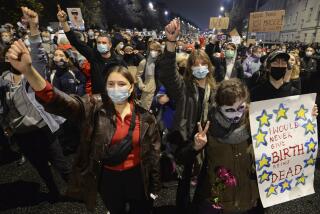Romania Follows Violent Revolution With Decade of Poverty and Despair
TIMISOARA, Romania — The flat, scruffy fields are empty and the potholed roads are full. The bustle of traffic past farms that are going bust is evidence that post-Communist Romania is losing its battle for prosperity.
Residents of this gloomy Balkan crossroads are taking to the highways west and south to smuggle gasoline to embargoed Yugoslavia. Farms are struggling because the ComTim pork processing behemoth is bankrupt and about to put even more disillusioned people out of work.
During the darkest days of Romania’s dictatorship, Timisoara was about the best location in a bad lot. From here, the hungry and harassed could watch the first tentative reforms take root in nearby Hungary. Their Yugoslav neighbors had freedom to travel and connections to the West.
If Romanians are looking for inspiration, the view now is depressing in both directions.
Having Yugoslavia for a neighbor during four wars and foreign economic embargoes has meant obstruction of vital trade routes. A look at Hungary is all the more disheartening because it illustrates how much more could have been accomplished if Romania’s post-revolution leaders had been much better than the ones who were thrown out.
Romania is the only place where the revolt against communism in 1989 turned violent. Soldiers fired on demonstrators. In the end, Communist dictator Nicolae Ceausescu and his wife, Elena, were executed.
It still is different. Romania and Bulgaria, its struggling neighbor in southeast Europe, are on the wrong side of what is looking like a new division of Europe.
Quality of life has improved imperceptibly as memories of Communist deprivation have faded. Borders are open. Citizens are free to speak their minds and seek their fortunes. But the establishment of democracy has coincided with the collapse of health care, education, public safety and a staggering exodus of the intellectual elite.
Romania wants to be a member of the NATO and the European Union, but so far it has fallen short of both.
“We can’t say it was better under Ceausescu because we were abused by him, too,” says Dimitru Radu, an unemployed welder and father of three who fills the tank of his battered white Romanian-made Dacia every day and sells the contents to farmers across the Yugoslav border whose supplies have been cut off by the foreign embargo. “But at least we had work then. My family wouldn’t eat now if I didn’t do this.”
He makes about $6 per run--if the border guards don’t demand too much in bribes.
While the economic landscape is livelier than a decade ago, the bursts of color provided by umbrella-shaded beer gardens and billboards hawking mobile telephones go unnoticed by the majority who cannot afford them.
Even in Timisoara, where the jobless rate is only 6% and two-thirds of the economy is private, disappointment is so pervasive that many expect the neo-Communist regime of former President Ion Iliescu to win elections next spring.
Petre Buligan is typical of the few Romanians who have been successful, mostly due to being in the power structure at the right time.
The owner of two clothing factories that employ 350 people, he got his start in the state-controlled foreign trade hierarchy under Ceausescu. His contacts with foreign buyers allowed him to secure deals in the free-market era, bankrolling his purchase of the two shops.
Bedecked in gold chains, a Swiss watch and diamond pinky ring, Buligan exudes the aura of the entire region’s nouveau riche. Those cutting, sewing and ironing for him take home less than $100 a month.
By regional standards, though, Buligan’s facilities are far from sweat shops. His employees, most of them women, decorate workplaces with plants and pictures of their children. The boss, known by his first name, stirs no panic when he drops in unexpectedly to survey his realm.
“I know I’m rich compared with most people, but my conscience can’t rejoice when I’m surrounded by so much poverty,” Buligan says. He blames Romania’s government for stiff taxes and restrictions on foreign trade that hinder any economic rebound.
Economist Nicolae Taran also blames Bucharest for constantly changing the rules for foreign investors.
Plagued by 90% annual inflation and sharply contracting national wealth, Romania has been steadily falling behind its northern neighbors and, as a result, nurtures fears of foreign intentions that verge on paranoia. The fate of ComTim is a telling example.
ComTim shows an annual profit of less than $4 million only because it receives state subsidies. Its delinquent loans amount to $22 million. The World Bank made its latest $150 million loan to Romania contingent on an end to government lifelines to bankrupt state enterprises, presenting Bucharest with the need to shutter ComTim unless it can find a foreign buyer.
“The World Bank is just an instrument of the United States and the European Union, which would like to eliminate ComTim’s competition in their own troubled meat industries,” claims Adrian Negoita, head of the company’s association of labor unions. “They want to force us to become an importer to help their own markets.”
There is also a stronger legacy of the old regime here than in other Eastern countries.
In his quest to create a Greater Romania of 30 million by the 21st century, Ceausescu outlawed birth control and abortion. So many unwanted children were born to parents who already had too many mouths to feed that squalid orphanages were inundated.
The dictator’s drive to staff urban factories stripped the countryside of peasants, producing a food shortage. Underlings were inspired to invent an Orwellian “scientific diet,” making a virtue of the necessity to starve the citizenry by limiting each person to 700 calories a day.
One remnant of that era is the overflowing population of Timisoara’s orphanages, home to 2,000 children in a city of 320,000.
“There are fewer newborns now because of the availability of contraceptives, but the number of children being abandoned has gone up because even more parents cannot afford to feed their children now,” says Manuela Borlea, a pediatrician who runs one home for 180 children younger than 3. Most of the parents still hope to take their children home one day.
While institutional life stunts development, says Borlea, conditions have improved dramatically from the filth and neglect that shocked the world when it learned of “Ceausescu’s children” after the revolution. Foreign charities provide food, clothing, toys and funding for attendants.
Part of the Ottoman Turkish or Austro-Hungarian empires for most of this millennium, Timisoara managed better than most regions of Romania during the Ceausescu era because of its location on the multicultural western border.
But those influences evaporated with the short-lived euphoria that followed Ceausescu’s overthrow. The industrious ethnic Germans who accounted for 12% of the population moved en masse to Germany. What remained of the Jewish community left for Israel.
Trade with Yugoslavia that once amounted to $500 million a year is now less than $50 million, says Emil Mateescu, head of Timisoara County’s chamber of commerce. But he concedes that an even heavier drag on the economy is the erratic parliament in Bucharest that has repeatedly moved the legal goal posts.
Despite the bleak outlook, with national unemployment expected to grow to 15% next year, there has been some progress.
Ethnic frictions between Romanians and the 2 million ethnic Hungarians in the country have been drastically reduced since the 1996 election of President Emil Constantinescu, whose center-right government shares power with a Hungarian minority party.
Daniel Kozak, head of the local office of the Open Society Foundation, which is part of philanthropist George Soros’s aid to democracy in Eastern Europe, says Romanians don’t like the economic or political situation. But they don’t want to go back, either: “Not even the most desperate people really want to live again under a totalitarian regime.”
More to Read
Sign up for Essential California
The most important California stories and recommendations in your inbox every morning.
You may occasionally receive promotional content from the Los Angeles Times.











